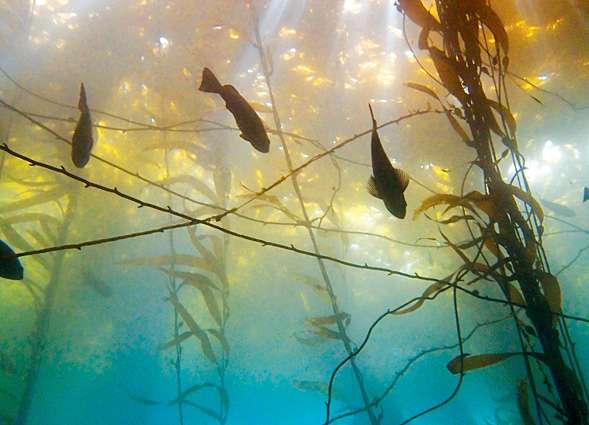San Diego's kelp forests are teeming with life

Below the San Diego coastline's pristine horizon lies a parallel world more akin to an ethereal rain forest than the sun-soaked scenery above. The region's underwater kelp forests are home to an incredibly diverse population of sea lions, fish, sharks, invertebrates and countless marine microbes, as well as—on a temporary basis—divers from San Diego State University studying this otherworldly environment.
"When the sun comes up and the water is clear, the sunlight filters through the kelp canopy and it's just gorgeous," said Matthew Haggerty, a graduate student who studies how kelp decomposition affects the surrounding microbial communities.
Haggerty is part of a team of SDSU researchers dedicated to learning more about how the largest, fastest-growing species of kelp on earth (Macrocystis pyrifera) interacts with the microscopic bacteria and viruses surrounding it.
Marine ecologist Elizabeth Dinsdale leads these efforts. She grew up in Australia, where the seas are similarly packed with kelp forests. In 2009, Dinsdale joined an expedition to the Line Islands led by SDSU virologist Forest Rohwer, who needed an expert on Pacific corals for the trip. Dinsdale fit the bill, and afterward she came to San Diego to work with Rohwer.
Her research looks at the many factors, including pollution and rising ocean temperatures, that affect the health of the kelp forests and the makeup of the microbes on and near the kelp. Lately, the range and density of local kelp forests have been fluctuating. Partly that's due to declining populations of sea otters in the area, Dinsdale explained. Sea urchins eat the kelp, and sea otters eat sea urchins. Without otters to keep the urchins in check, the urchins can decimate a kelp forest.
"When you lose the kelp, the species diversity plummets and you lose the fish, the sharks, the sea lions—basically everything but the urchins," she said.
And there's no telling whether the kelp will grow back. Researchers hypothesize that it may need help from specific microbes to survive. Dinsdale and her team perform a number of experiments off the coast of Point Loma and Catalina Island to learn how different microbes influence kelp growth and health. They take advantage of SDSU's Coastal and Marine Institute Laboratory in Point Loma as a research base for the kelp used in experiments.
Megan Morris, another graduate student who works in Dinsdale's laboratory, is trying to discover why the bacteria found on Catalina Island kelp seem to foster kelp growth while Point Loma kelp bacteria appear to inhibit it.
Morris said the effect might be related to a difference in growth hormone in the microbes. No one knows the answer yet, but solving this mystery will be one more step in the struggle to better understand and protect the kelp forests and their myriad watery residents.
Provided by San Diego State University



















